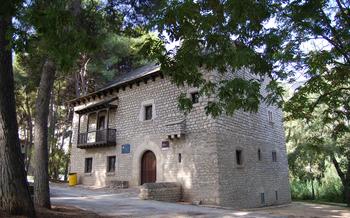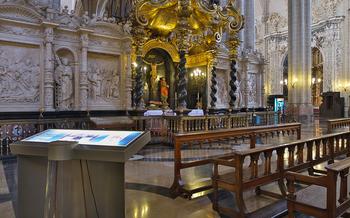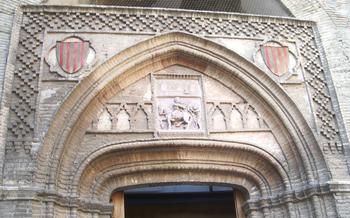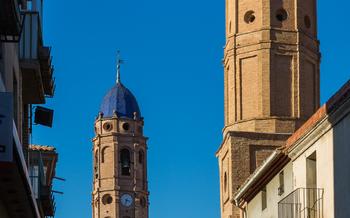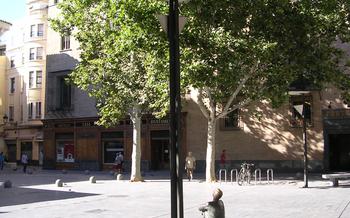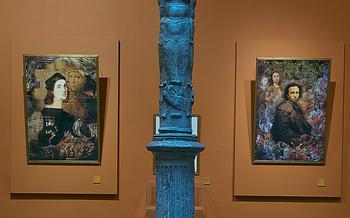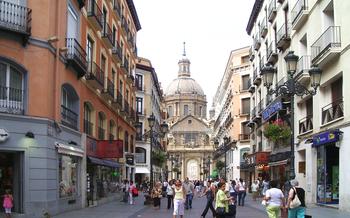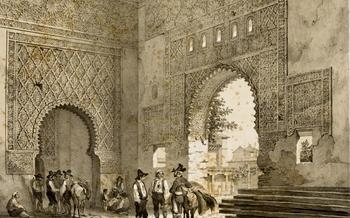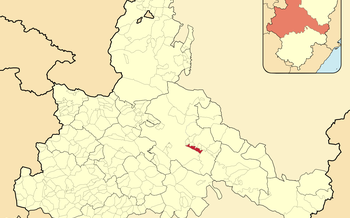
Castillo de la Aljafería
- Castillo de la Aljafería: A Majestic Blend of Cultures
- Exploring the Castle's Interior: A Journey Through History
- The Museum of Islamic Art: Unveiling a Cultural Heritage
- The Royal Courtyard: Grandeur and Elegance
- The Hall of Kings: Portraits and History
- The Albarrana Tower: A Strategic Defense
- Mudejar Elements: A Blend of Cultures
- Special Events and Exhibitions: A Dynamic Cultural Venue
- The Surrounding Area: Exploring Zaragoza's Treasures
- Photography Tips: Capturing the Essence of the Castle
- Insider Tip: Hidden Gems and Secret Spots
Castillo de la Aljafería: A Majestic Blend of Cultures
Architecture: A Tapestry of Styles The castle's design is a captivating fusion of Islamic and Gothic elements. Its origins as a Moorish palace are evident in the horseshoe arches, intricate tilework, and geometric patterns that adorn its walls. As the Christian reconquest progressed, Gothic influences were incorporated, resulting in a harmonious blend of architectural styles.
Cultural Significance: A Symbol of Diversity The Castillo de la Aljafería served as a royal residence during the Islamic and Christian periods, embodying the city's multicultural legacy. It witnessed the coexistence of different cultures and religions, leaving an indelible mark on Zaragoza's identity.
Practical Information: Unveiling the Castle's Treasures Visiting the Castillo de la Aljafería is an enriching experience that transports visitors back in time. The castle is open to the public with guided tours available to unravel its captivating history. Admission fees are reasonable, and the castle is wheelchair accessible, ensuring inclusivity for all visitors.
Exploring the Castle's Interior: A Journey Through History
Step inside the Castillo de la Aljafería and embark on a journey through time. The central courtyard, surrounded by elegant arcades and lush gardens, welcomes you with its serene atmosphere. Marvel at the grandeur of the Throne Room, where intricate ceiling decorations and stunning city views create a majestic ambiance. Discover the Islamic origins of the castle in the Muslim Prayer Room, adorned with exquisite stucco carvings that tell tales of a bygone era. Finally, visit the Chapel of San Martin, a later addition showcasing Gothic architecture and religious art, blending harmoniously with the castle's Islamic heritage.
The Museum of Islamic Art: Unveiling a Cultural Heritage
The Museum of Islamic Art, housed within the Castillo de la Aljafería, offers a fascinating journey into the rich artistic legacy of Islamic civilization in Spain. Its collection showcases a diverse range of artifacts, including intricate ceramics, finely woven textiles, and gleaming metalwork, providing a glimpse into the region's vibrant past.
Explore the museum's exhibits to learn about the development of Islamic art in Spain, from its early roots to its flourishing during the medieval period. Discover how Islamic artisans blended influences from various cultures, creating a unique style characterized by geometric patterns, intricate calligraphy, and vibrant colors.
Engage with interactive displays that provide insights into the techniques and materials used by Islamic artists. Learn about the painstaking process of ceramic glazing, the intricate weaving of textiles, and the delicate craftsmanship of metalwork. These interactive exhibits bring the artistic traditions of the past to life, allowing visitors to appreciate the skill and dedication of Islamic artisans.
Admission fees to the museum are reasonable, and guided tours are available for a more in-depth exploration of the collection. The museum also hosts special programs and educational workshops throughout the year, offering visitors the opportunity to delve deeper into the world of Islamic art and culture.
The Royal Courtyard: Grandeur and Elegance
The Royal Courtyard is a stunning display of architectural grandeur and historical significance. Its grand arches, intricate carvings, and elegant details create an awe-inspiring space that reflects the opulence and power of the Aragonese monarchy.
Once the setting for lavish royal ceremonies, receptions, and important events, the Royal Courtyard exudes an air of majesty. Its elegant arches and intricate carvings showcase the skill and artistry of the craftsmen who worked on its construction. The courtyard's design evokes a sense of grandeur, with its spacious layout and symmetrical arrangement of architectural elements.
Beyond its architectural beauty, the Royal Courtyard holds great historical significance. It was here that the kings and queens of Aragon hosted important guests, celebrated victories, and conducted official business. The courtyard served as a central gathering place for the royal court, where decisions were made and alliances were forged.
The Hall of Kings: Portraits and History
The Hall of Kings is a remarkable chamber within the Castillo de la Aljafería, dedicated to showcasing the portraits of Aragonese kings and queens who have shaped the region's history. These portraits offer a glimpse into the lineage and legacy of the Aragonese monarchy, providing visitors with a deeper understanding of the kingdom's past.
As you enter the hall, you are greeted by a majestic collection of portraits, each depicting a different ruler. The artistic styles vary from medieval to Renaissance, reflecting the changing tastes and influences that have shaped Aragonese art over the centuries. Some portraits are simple and straightforward, while others are adorned with elaborate details and symbolism, highlighting the power and prestige of the monarchy.
Through these portraits, visitors can learn about the historical context of each reign, the challenges and triumphs faced by these rulers, and their impact on the development of Aragon. The Hall of Kings serves as a testament to the rich history of the region and the enduring legacy of its monarchs.
The Albarrana Tower: A Strategic Defense
Positioned strategically outside the castle walls, the Albarrana Tower served as a crucial defensive fortification. Its unique design, featuring horseshoe arches and intricate brickwork, showcased the architectural prowess of the era. During times of siege, the tower provided a secure refuge for defenders, allowing them to repel attacks and protect the castle's integrity. Explore this remarkable structure to gain insights into the ingenious defense mechanisms employed by medieval fortresses.
Mudejar Elements: A Blend of Cultures
The Castillo de la Aljafería is a testament to the rich cultural exchange between the Christian and Islamic communities during the Middle Ages. The castle's architecture and decoration showcase a harmonious blend of Islamic and Christian artistic elements, known as the Mudejar style. This unique style emerged as Muslim artisans and craftsmen worked alongside their Christian counterparts, creating a fusion of artistic traditions.
Look out for the distinctive horseshoe arches, a hallmark of Islamic architecture, which are used throughout the castle. The intricate geometric patterns and glazed tiles that adorn the walls and ceilings further reflect the Islamic influence. These decorative elements create a sense of opulence and grandeur, adding to the castle's overall aesthetic appeal.
The Mudejar elements in the Castillo de la Aljafería serve as a reminder of the diverse cultural heritage of Spain and the lasting impact of Islamic art and architecture on the region. By exploring these unique features, visitors can gain a deeper understanding of the castle's history and the cultural exchange that shaped its design.
Practical Information:
Guided tours of the castle often include explanations and insights into the Mudejar elements. Visitors can also find informative panels and signage throughout the castle that provide further details about the Mudejar style.
Special Events and Exhibitions: A Dynamic Cultural Venue
The Castillo de la Aljafería is not just a historical monument but also a vibrant cultural venue that hosts a variety of events and exhibitions throughout the year. Regular events include concerts, theater performances, and festivals that showcase the castle's rich heritage and cultural significance. Temporary exhibitions feature historical artifacts, art collections, and contemporary works, offering visitors an opportunity to explore different aspects of the castle's history and culture.
For those interested in delving deeper into the castle's stories, guided tours are available that focus on specific themes or periods. Educational programs and workshops are also organized for children and adults, providing hands-on experiences and insights into the castle's architecture, art, and history.
Event schedules, ticket prices, and online booking options are available on the castle's official website. Visitors are encouraged to check the calendar of events before their visit to plan their trip accordingly and make the most of the cultural offerings at the Castillo de la Aljafería.
The Surrounding Area: Exploring Zaragoza's Treasures
Beyond the walls of the Castillo de la Aljafería, the city of Zaragoza unveils a treasure trove of historical landmarks, culinary delights, and shopping experiences. Discover the majestic Zaragoza Cathedral, a stunning example of Gothic architecture, and marvel at the Mudejar beauty of the Aljafería Palace. Stroll through the vibrant Plaza del Pilar, the heart of the city, and immerse yourself in its lively atmosphere.
For a taste of local flavors, venture into the nearby restaurants and tapas bars, where you can savor traditional Aragonese dishes prepared with fresh, seasonal ingredients. Explore the vibrant markets, such as the Mercado Central, and indulge in the sights, sounds, and aromas of local produce, spices, and artisanal products.
Zaragoza offers a delightful blend of history, culture, and gastronomy, ensuring an unforgettable experience for every visitor. Whether you're a history buff, a foodie, or simply seeking a vibrant urban escape, Zaragoza has something to offer.
Photography Tips: Capturing the Essence of the Castle
Best Angles and Lighting:
The best time to photograph the Castillo de la Aljafería is during the golden hours, just after sunrise or before sunset, when the warm light illuminates the castle's architecture and gardens. For dramatic shots, position yourself at the base of the tower to capture the castle's grandeur against the sky or frame it through the trees for a more intimate perspective.
Composition and Perspective:
To create visually appealing compositions, use the rule of thirds to place the castle off-center and add depth to your shots by incorporating foreground elements like trees or flowers. Experiment with different perspectives by shooting from above or below to emphasize the castle's height or reveal hidden details.
Camera Settings and Equipment:
For sharp images, use a tripod to stabilize your camera and select a low ISO to minimize noise. Adjust the aperture to control the depth of field, blurring the background to make the castle stand out. A wide-angle lens is ideal for capturing the castle's grandeur, while a telephoto lens can zoom in on specific details.
Practical Information:
The castle allows photography, but tripods may be restricted in certain areas. To avoid crowds, visit during off-peak hours or on weekdays. Check the weather forecast before your visit to plan for the best lighting conditions.
Insider Tip: Hidden Gems and Secret Spots
Beyond the main attractions, the Castillo de la Aljafería holds hidden gems and secret spots that reveal its rich history and offer unique perspectives. Explore the lesser-known areas of the castle to discover secluded courtyards, hidden passageways, and stunning viewpoints. Look for intricate carvings, inscriptions, and architectural details that tell stories of the past. Engage with local guides or historians to uncover the castle's secrets and gain insights into its hidden corners. Remember to prioritize safety and respect for the castle's preservation while exploring these hidden areas.
